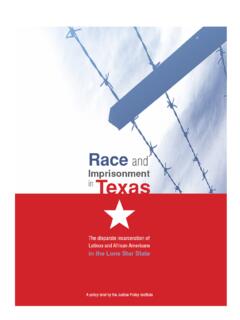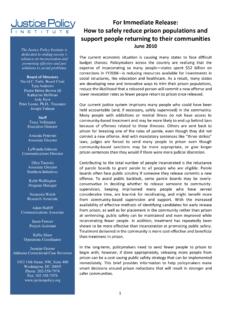Transcription of Expensive, Ineffective and Unfair - justicepolicy.org
1 Virginia s justice system is expensive, Ineffective and inequitable. Despite some recent small progress in the areas of post incarceration reentry, particularly felony disenfranchisement, the state continues to suffer under misguided policies and practices of the past. KEY POINTS: Expensive Virginia s Public Safety Office and Judiciary have combined annual budgets of nearly $3 billion, representing percent of the total general and non general state expenditures. The annual cost to confine an individual in state prison is more than $25,000, with inflated health care costs for the increasing numbers of prisoners over the age of 50. Virginia spends roughly $ billion a year to operate crowded jails and prisons. The cost to incarcerate a young person in a juvenile facility is roughly $100,000 per year. Small, sensible changes to state statutes can make a big difference.
2 Changing the amount that distinguishes larceny from grand larceny from $200 to $600 could save the state approximately $ million over six years. In 2011, Virginia spent more than $94 million on drug arrests alone. While other states like Washington and Colorado have begun to question and revise policies and practices that prioritize drug law enforcement , Virginia has shown no movement in this area. Ineffective The tough on crime, so called truth in sentencing laws enacted in the 1990s have failed in driving down crime or recidivism. They have only driven up costs and created a larger group of people who carry the burden of post incarceration collateral consequences. Virginia s aggressive stance on arresting people for drug violations has had no effect on reducing drug use. In fact, illicit drug use has increased in recent years.
3 Inequitable People of color, particularly African Americans, are over represented at each stage of the Virginia criminal justice system. In Virginia, African Americans comprise roughly 20 percent of the adult population. In the justice system, they comprise: percent of all arrests percent of robbery arrests percent of aggravated assault arrests percent of state prison inmates (For every white person incarcerated in Virginia, six African Americans are behind bars) As a result of the figures above, percent of African American Virginians have lost the right to vote, isolating them from their communities and civic participation. VIRGINIA S JUSTICE SYSTEM: Expensive, Ineffective and Unfair NOVEMBER 2013 JUSTICE POLICY INSTITUTE 2 Virginia ranks low in Violent and Property crime nationally, but high in incarceration and spending State Ranking Ranking Violent Crime, 2011 46th Property Crime, 2011 43rd Federal & State Incarceration Rate, 2011 13th Adult Community Supervision Rate, 2007 44th General Funds Spending on Corrections, 2008 11th Sources: Virginia Performs, Crime, July, 2013, ; Pew Center on the States, One in 31: The Long Reach of American Corrections, (Washington, DC, 2009).
4 In August of 2013, Attorney General Eric Holder addressed the annual meeting of the American Bar Association, lamenting the fact that too many Americans go to too many prisons for far too long, and for no truly good law enforcement reason. He also questioned whether our war on drugs has been truly effective, and has led to an outsized, unnecessarily large prison population. Holder s speech not only provided a critique of our justice system that is in too many respects broken, but urged action to address these The Attorney General s remarks are especially applicable to Virginia, a state that, despite experiencing a decline in overall crime over the past decade, continues to spend vast amounts of money on arresting and confining its citizens with little to show apart from high incarceration rates and strained budgets.
5 INTRODUCTION Virginia has enjoyed a steady decline in crime over the last two decades. As of 2011, the state showed crime rates well below the national average for most offenses. However, so called tough on crime policies enacted in the mid 1990s have led to over incarceration in the state with jails and prisons suffering from crowding and expensive maintenance. This report provides an overview of Virginia s criminal justice system and a brief look at juvenile justice statistics, with an eye toward identifying problem areas and potential solutions. As with other states and the nation as a whole, justice systems are complex and, sadly, rife with areas of urgently needed reform. This report does not claim to cover all aspects of Virginia s justice system or possible solutions. The selection of a new governor in 2013 allows Virginians an opportunity to take a fresh look at the challenges created by decades of over punishment and the associated costs.
6 In a poll of prospective voters however, less than one percent of respondents named crime and public safety issues as priorities, thirty seven percent named the economy as the top issue guiding their vote and twelve percent named the This may be a welcome stance given that crime is low and not at the top of voters social concerns. Because Virginia s system of handling crime and public safety is overly institutional and expensive, thinking about the economy and budget requires reconsidering the state s criminal justice systems. Some, like former Governor George Allen, whose 1994 campaign was successful largely due to a tough on crime, prison focused platform, has attributed the state s drop in crime to the practice of putting more people behind bars for In truth, evidence shows crime rates to be relatively independent of incarceration practices and findings specific to Virginia have also found longer prison terms to be Ineffective at reducing recidivism by released VIRGINIA S JUSTICE SYSTEM 3 Virginia s adherence to onerous justice policies that were more common thirty years ago puts the state increasingly out of step with its neighbors and many states across the nation.
7 As shown in the table on page 6, despite relatively low overall crime rates, Virginia s practice of mass incarceration and the costs that come with it put the state near the other end of the ranking scale. EVEN WITH DECLINING CRIME, ARRESTS IN VA HAVE REMAINED STABLE. Overall, crime has decreased in Virginia over the last two decades, a trend experienced across the country. However, the number of arrests (as opposed to the rate of arrest) in the state has remained relatively stable, falling only percent. This can be attributed to a greater number of arrests for drug violations, a phenomenon that has occurred nationally. Compared to other states and the national average, Virginia has low rates of reported In 2011, the state had the 5th lowest a It is important to note that reported offenses represent the number of offenses reported by law enforcement to the FBI s Uniform Crime Reporting violent crime rate at per 100,000 people, about half of the national rate.
8 The 2011 property crime rate was the 8th lowest in the at 2, per 100,000 people. Virginia s violent and property crime rates have fallen in the last decade (by 33 percent and 22 percent, respectively), mirroring the trend of crime rates across the country. In contrast to declining violent and property offenses, the number of reported drug offenses increased by nearly half during the same period, from 34,404 to 50,650, an issue that will be discussed in further detail below. Between 2002 and 2011, Virginia s overall arrest rate fell by percent; much less than the 33 percent and 22 percent drop in reported major crime. However, disaggregating arrests for various offenses shows increases in some areas. For example, the arrest rate for Group A offenses those considered the most serious increased by percent, driven by a rise in arrests for drug offenses, kidnapping, robbery, shoplifting and larceny.
9 Arrest rates for Group B offenses,5 which include many non violent violations such as disorderly conduct and liquor program, not offenses reported to law enforcement by citizens. That said, reported offense counts, much like arrest counts, reflect law enforcement activity. Changes in arrest rates (per 100,000) varied by category from 2002 to 2011 2002 2011 Change Arrests, rate Group A arrest rate % Group B arrest rate % Violent offense arrest rate % Drug offense arrest rate % Source: Crime in Virginia, annual editions 2001-2011; Crime in the United States, annual editions 2001-2011. JUSTICE POLICY INSTITUTE 4 Source: Crime in Virginia, annual editions 2002 2011 25,24436,40824,00026,00028,00030,00032,0 0034,00036,00038,0002002 2003 2004 2005 2006 2007 2008 2009 2010 2011 Number of drug arrestsArrests for drug offenses increased steadily between 2002 and to the national trend, in the past 10 years Virginia has seen violent and property crime rates decline 33 and 22 percent, respectively.
10 Source: Crime in Virginia, annual editions 2001 2011; Crime in the United States, annual editions 2001 2011. per 100,000 residentsViolent Crime rate USViolent Crime rate , , per 100,000 residentsProperty crime rate USProperty crime rate VAlaw violations, decreased by 24 percent from 2,894 to 2,199 per 100,000. Drug Arrests Similar to other jurisdictions across the country, drug arrests in Virginia have increased in contrast to violent and property offense arrests, to a large extent negating the decline in overall crime. As more police funding has been tied to performance measures ( , number of arrests), police departments have often been forced to shift focus to low level, non violent drug violations as a means to help maintain or increase numbers and, thus, Unable to make arrest quotas through arrests for serious crime, enforcement has turned to arresting people who otherwise would go unnoticed and pose a relatively low public safety risk to communities.








